EARTHQUAKES, TSUNAMIS AND FIRES
The first signs of trouble are partial repairs and the absence of repairs after earthquakes, tsunamis and fires. Some natural disasters are documented in texts and inscriptions. In 44 BC a portent is mentioned that must be related to a tsunami: "In Ostia a shoal of fish was left on dry land by the retracting of the sea". In 62 AD as much as 200 ships perished in the harbour of Claudius during "a violent storm". In view of the scale this was more likely a tsunami, and it may not be a coincidence that in the same year Pompeii was struck by an earthquake. In 196 AD Septimius Severus "restored a column broken by the force of a storm" in Portus. There is also archaeological evidence for natural disasters. When beams of ceilings rot away, or when a building is destroyed by a fire, the walls tend to fall inward. When an earthquake occurs, walls tend to fall outward. So when a collapsed wall was found on a street, an earthquake is the likely culprit.
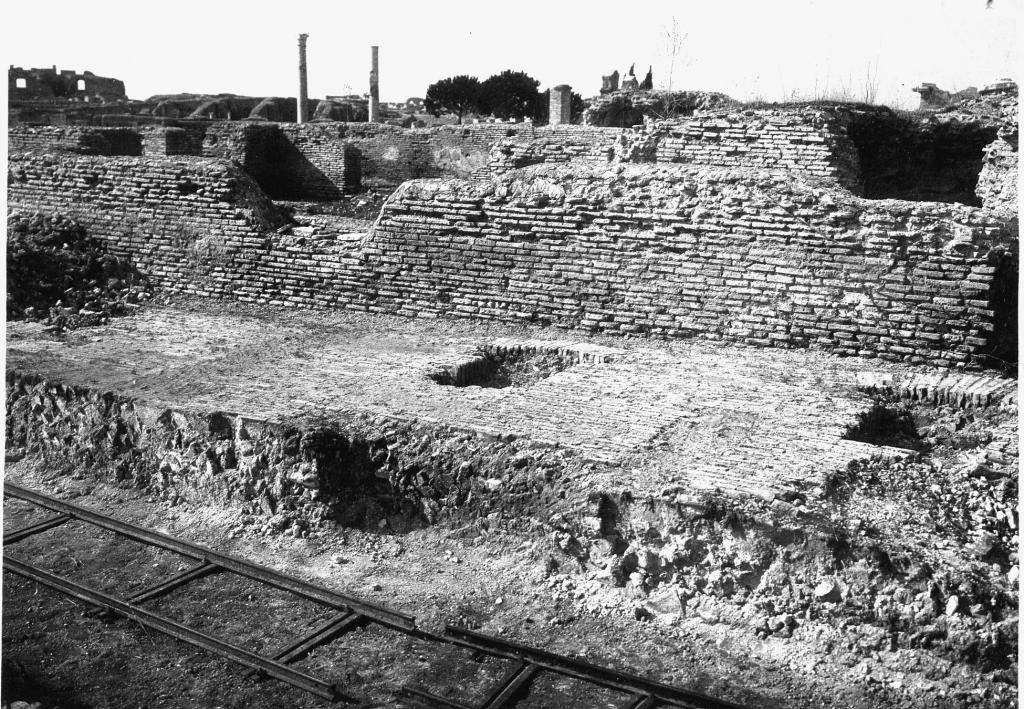
A facade that collapsed and fell on Via del Tempio Rotondo, presumably during an earthquake, in the third or fourth century.
The facade belongs to the House on Via del Tempio Rotondo (IV,IV,7) and is still lying on the street.
Photo: Archivio Fotografico Ostia, neg. B 3082.
An earthquake may cause irregular, vertical cracks in the walls. The underground wave of an earthquake may push a wall upward. The upper part may then become detached, and when it lands on the lower part, it will stick out a few centimeters. There may also be torsion, a twisting of the upper part.
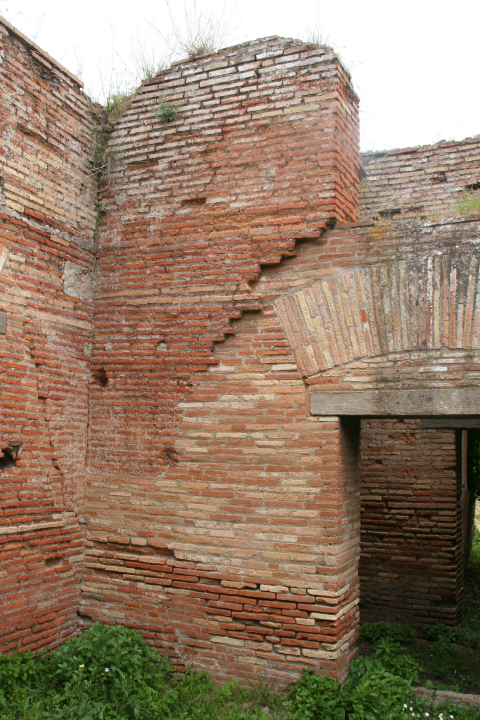 |
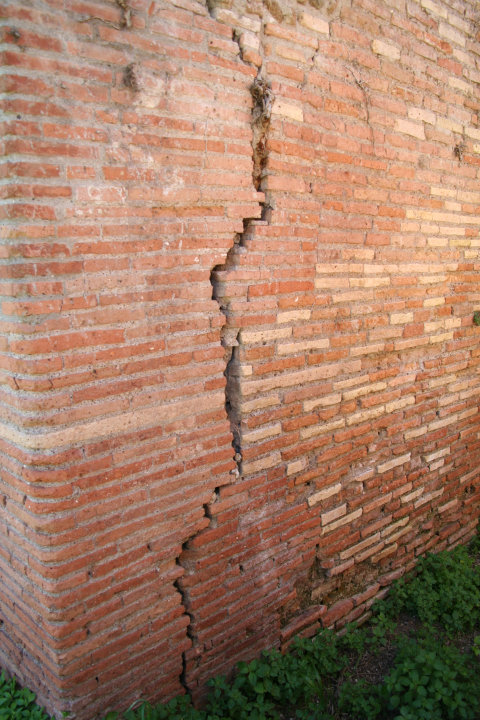 |
| Typical earthquake damage in the House of Hercules (IV,II,2-4). Photos: Jan Theo Bakker. Left: the upper part of the wall is sticking out a few centimeters. Right: a crack resulting from an earthquake. |
|
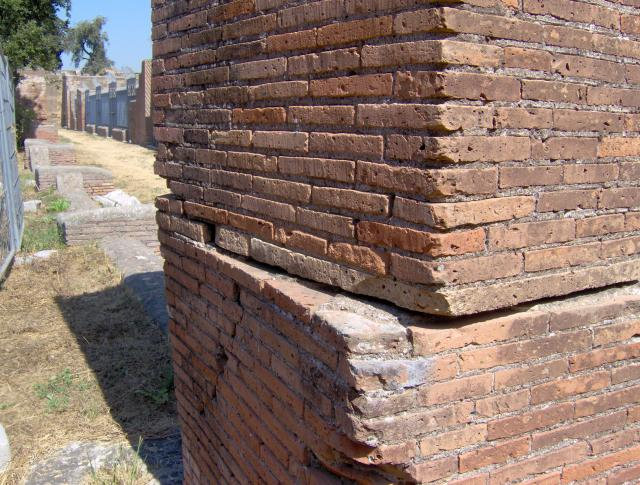
Another example of earthquake damage. Photo: Antonia Arnoldus.
Twisting of a pier in the Small Market (I,VIII,1).
In Portus the excavators saw traces of several earthquakes and tsunamis that must have taken place in the third and fourth century. In a cistern in Portus corpses were found below deposits resulting from a tsunami, perhaps combined with an earthquake. On the corpses coins were found from 236 and 238 AD.[1] Work near the coast to the south of Ostia, in 238 AD, may be related. In that year Maximinus Augustus and Maximus Caesar repaired the road leading from Ostia to Antium after it had been damaged by the sea.[2] The first building in Ostia of which we know that it ceased to function are the Baths of the Swimmer (V,X,3). An accurate excavation has shown that it was abandoned in the years 240-250 AD. The date suggests a relation with the same seismic activity, apparently in 238 AD.
There seem to have been two earthquakes in Ostia in the third quarter of the third century, one in 275 AD, the other during the reign of Probus (276-282 AD) or a little later. As to the earthquake in 275, the Historia Augusta tells us about the Emperor Tacitus (275-276 AD) that among the omens predicting his death was this: "All the gods in their private chapel fell down, overthrown either by an earthquake or by some mischance". The House of the Priestesses (III,IX,6), part of the Garden Houses, was destroyed in the last quarter of the third century, witness coins from the reigns of Gallienus (253-268) and Aurelianus (270-275). The ceiling of the ground floor and the upper stories had collapsed. Traces of fire are not reported. The ruins were not cleared in antiquity. The bakery in the House of the Millstones (I,III,1) was destroyed by a fire at the end of the third century, witness coins, the latest of which belong to the reign of Probus (276-282). The ruins were again not cleared. A very large number of coins was found in the adjacent House of Diana (I,III,3-4), a series also ending during the reign of Probus. In this building no traces of fire were seen, pointing to an earthquake, and suggesting that the fire in the House of the Millstones was the result of this earthquake. The building to the north, the House of the Mithraeum of Menander (I,III,5), also seems to have burned down.
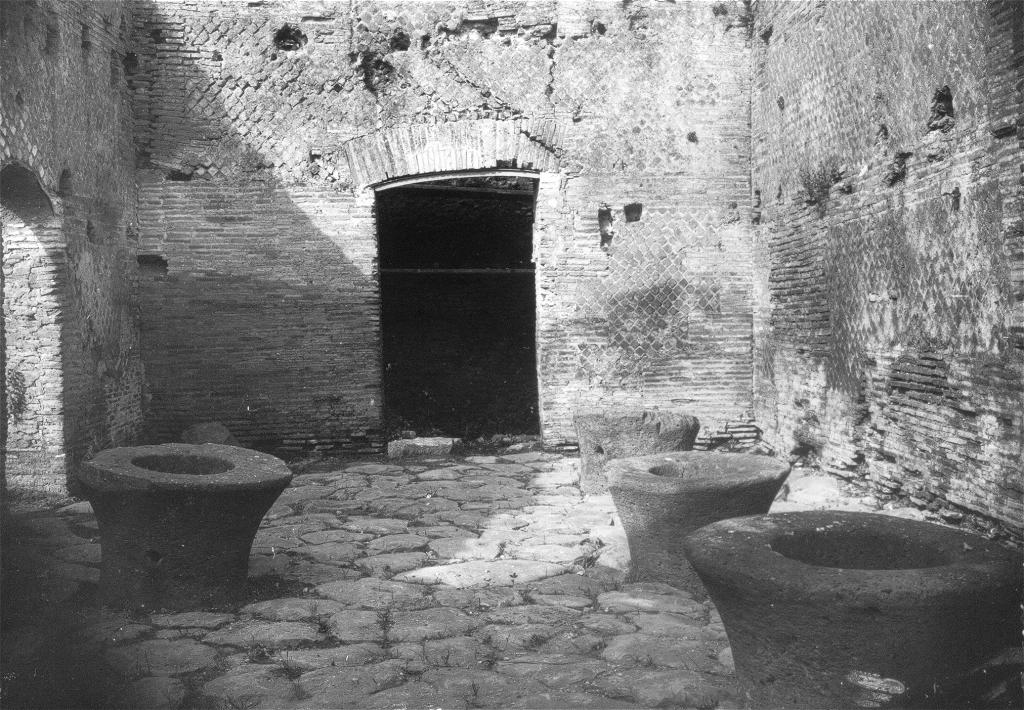
A room with kneading machines for dough in the House of the Millstones (I,III,1).
After a devastating fire the machines were not extracted from the building.
Photo: Archivio Fotografico Ostia, neg. B 2201.
Michael Heinzelmann has noted that a very large suburban villa near the beach was destroyed by an earthquake at the end of the third century. The earthquake was deduced from the fact that collapsed walls and ceilings were found directly on the floor, not on a layer of debris. In rooms along the Via del Sabazeo many traces of a fire were found on top of coins from the second and third century. Heinzelmann also reports that a luxurious house near the so-called Imperial Palace was destroyed by an earthquake in late antiquity. A small harbour in the north-west part of the city was struck by a tsunami in the third quarter of the fourth century. We know of a major earthquake in 346 AD, about which Hieronymus says: "For three days and three nights Rome was shaken and numerous towns in Campania were struck".[3] There was a smaller one in 375 AD.
Destruction could also be the work of the inhabitants. Some pagan structures seem to have been destroyed by Christians, after the conversion of Constantine. To the south of the House of Diana is a little square with a crossroads-shrine, a compitum. To the shrine belongs a round, marble altar. Parts of the upper cornice and the inscription have been hammered off, and the reliefs were heavily damaged. Some of the fragments were found nearby, one used for the repair of a road. The statue of Mithras in the Mithraeum of the Baths of Mithras (I,VII,2) was seriously damaged, and parts were thrown in a drain. It is probably not a coincidence that a Christian oratory or little church was built near the mithraeum, in the second half of the fourth or in the fifth century. The worshippers of the Magna Mater seem to have been prepared for disaster, expecting destruction by Christians or by approaching Goths or Vandals. Many dedications by the guild of the reed-bearers (cannophori) were found in a niche in the back wall of the podium of the Temple of the Magna Mater (IV,I,1), walled in. Several objects from the nearby Sanctuary of Attis (IV,I,3) seem to have been hidden in the porticus along the south side of the Field of the Magna Mater.
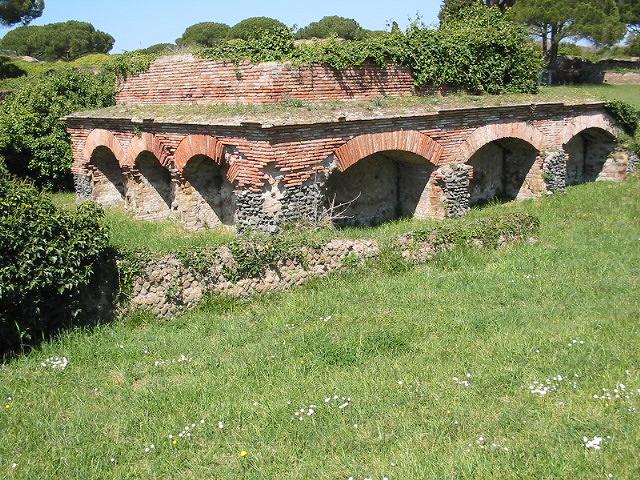
The podium of the Temple of the Magna Mater. Photo: Jan Theo Bakker.
Statues had been walled in in a niche of the back side (left).
[1] Scrinari 1984, 218; 1987, 182.
[2] CIL X, 6811.
[3] F. Galadini - P. Galli, "The 346 A.D. earthquake (Central-Southern Italy): an archaeoseismological approach", Annals of Geophysics 47, 2/3 (2004), 885-905.